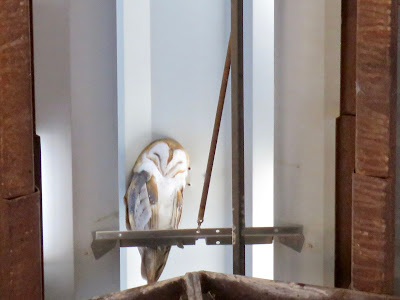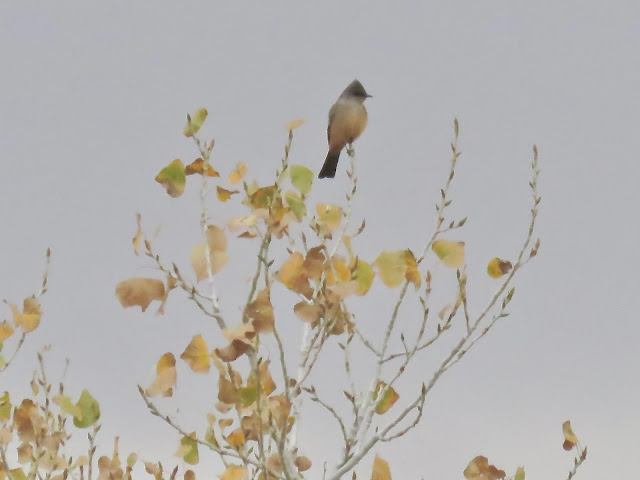In the wee hours of the morning, I felt rested and wide awake. What better to do than check out the birds at a spot I haven't visited for quite some time?
Arriving at Bushnell Sheep Tank (a bit past Sunflower on Route 87 to Payson) at 7:15 a.m., was not the best plan in the world. It was 31°.
Dressed in layers plus a wool pull-down hat, I was warm enough to start out on the road beyond the gate to watch the sun rise over the hills and into Sycamore Creek's cottonwoods, sycamores and willows. The only birds active were NORTHERN FLICKERs, but I heard DARK-EYED JUNCOs (the orignal snowbirds) in the weeds and under shrubs.
 |
| NORTHERN FLICKER - RED-SHAFTED - a bit fluffed up on this cold morning |
One mile later, after a brief uphill climb, I stood and enjoyed the view. The hill was sunlit and I caught a small flock of bluebirds come into a tree. As my cold fingers got my camera ready for a shot, most of the flock took off, but two remained - a male and female. As it turned out, they were the EASTERN BLUEBIRDs prevously reported from this location -- a bit out of range, but putting some spice into the still-cold air.
 |
| Male (bottom) & female (top) EASTERN BLUEBIRD |
Soon I was seeing other birds, including WOODHOUSE'S SCRUB JAY, BRIDLED and JUNIPER TITMOUSE, HERMIT THRUSH and other expected birds for this habitat. The sun had finally warmed the creek area; it was a beautiful day. WESTERN BLUEBIRDs came and went; several AMERICAN ROBINs showed up individually and briefly and a tree full of CASSIN'S FINCH caught my eye. My hands were slower, but there was one left in the tree for a photo good enough for the ID.
The only other decent bird photo there was one I identified as a young GRAY FLYCATCHER.
 |
| Immature GRAY FLYCATCHER |
View this checklist online at http://ebird.org/ebird/view/checklist/S42254854
Saturday, January 27, 2018
Having caught up on necessary chores after birding yesterday, I was free to head out again in the morning. Today, Jeanne Burns and Hinde Silver joined me for a trip up to Lake Pleasant to see how many of the rarities being reported we might be able to find.
Ooops! Although it was a toasty (!) 49°F when we arrived at Ten Lane Boat Ramp, white caps on the lake told another story. WIND...WIND...and more WIND. Jeanne and Hinde got out and birded for several minutes before heading back to the car. I scanned and scanned and scanned. AMERICAN COOT and MALLARD were not on our "treasure hunt" list. Neither was the next bird we saw, but it was a good one: a 3-year BALD EAGLE with white head and tail just beginning to feather up to replace the black.
Land birds began to get our attention. Two ROCK WRENs were not shy and perched up for us.
 |
| ROCK WREN |
Boat traffic was picking up on this weekend day.
So, we drove to the Yavapai County portion of Lake Pleasant where we did pick up some birds that pacified us for the long drive and way-too-windy conditions.
A huge flotilla of CLARK'S GREBE appeared to be out in the distance. Most appeared to have a black cap with white face and neck down to water's edge, but with so many out there and beyond our scope views, we decided it was mixed flock of CLARK'S and WESTERN GREBE.
One of the grebes within camera range was a HORNED GREBE, shown below.
 |
| HORNED GREBE |
View this checklist online at http://ebird.org/ebird/view/checklist/S42289796
View this checklist online at http://ebird.org/ebird/view/checklist/S42290096
Sunday, January 28, 2018
 |
| Photo by Glenda Jones |
We began birding at 8:20 a.m. among the thousands of birds up early to feed in these beautiful grasslands. Straw-like grass is all over the place, so that a bird that is seen one moment is out of sight the next. We planned to stay for several hours as we knew this was difficult birding, especially when it's for less common birds. We had chairs; we had our spotting scopes, binoculars and cameras.
My goal of "studying" the longspurs defaulted to learning a great deal about HORNED LARKs that were present in great numbers.
 |
| HORNED LARK |
 |
| Cattle walking past Glenda's car to the tank for water |
 |
| Glenda, sorting through sparrows, larks and longspurs |
I was actually taking a photo of some birds when he called out that it was a nice BAIRD'S SPARROW. Well, thank you, Homer, I should have known, but lighting was not showing its yellow. I was taking the pic because it was bigger and different!
 |
| BAIRD'S SPARROW (top and bottom) |
Considering the conditons, the above photos were the best from this location. Mostly, we were scoping through the muck next to the pond where all the birds and several longspurs gathered.
 |
| In the fore-center of the photo above is a SAVANNAH SPARROW |
Birds, including several SAVANNAH SPARROWs as above, were feasting on the bugs and tidbits offered within this shallow manure pile
Finding our longspurs in the scope became easy enough after awhile. But, moving from scope to camera and finding it again was a relentless frustraton.
One CHESTNUT-COLLARED LONGSPUR was, at least, partially into its breeding plumage.
 |
| Poor quality photo of CHESTNUT-COLLARED LONGSPUR transitioning to breeding plumage |
Mostly, I was finding females of the two species.
 |
| CHESTNUT-COLLARS LONGSPUR |
 |
| McCOWN'S LONGSPUR |
Winds began to pick up by our 3rd hour, so we hauled out without waiting for the LAPLAND LONGSPUR to arrive on the scene. But we weren't finished with our day.
At the Paton Center for Hummingbirds (Patons' Yard) in Patagonia, we spent an hour enjoying the renovated birding area, woodland area and back yard. Our most interesting sighting there were two humming birds in a tree appearing to do mating behavior. The one was a VIOLET-CROWNED HUMMINGBIRD with some filament stuck on her beak (at first we thought it was her tongue). With sunlight flicking off the filament, a male ANNA'S HUMMINGBIRD went into a dipping, stretching, swaying movement side to side; he could not get enough of this VIOLET-CROWNED HUMMINGBIRD. After thinking about it, though, it seemed the VCHU was in trouble as the edges of its beak were also worn.
We stopped a few other places on the way north on I-19 to check out the birding situation but decided to head directly to SANTA RITA LODGE in Madera Canyon. Instead of going hunting for birds, we would sit and let them come to us. What a good choice that became!
Spotting 21 good species there within half an hour was awesome. A young couple who found our knowledge helpful, couldn't believe they had just seen five (5) LIFERS in five (5) minutes! RIVOLI'S HUMMINGBIRD (male and female), ARIZONA WOODPECKER, PAINTED REDSTART, RUFOUS-WINGED SPARROW, YELLOW-EYED JUNCO AND CANYON TOWHEE were among the best of the lot.
Altogether, a day not soon forgotten.
View this checklist online at http://ebird.org/ebird/view/checklist/S42335408
View this checklist online at http://ebird.org/ebird/view/checklist/S42335644
View this checklist online at http://ebird.org/ebird/view/checklist/S42336035
Monday, January 28, 2018
I've been enjoying some good birding with a neighborhood group of birders. Today's outing at Boyce Thompson Arboretum began at 9 a.m. and lasted right up 'til noontime. In between, walking at least two miles of trail, we came up with 26 species of birds.
In the Children's Garden, we had a nice find: a Slate-colored FOX SPARROW. We would see another one later across from the herb garden.
 |
| FOX SPARROW - head cut off but clear sharp photo of face, throat, chest and belly |
A big thrill for me was to finally get a clear photo of a WHITE-THROATED SPARROW.
 |
| WHITE-THROATED SPARROW (two above photos) |
Back in the picnic area as we finished up for the morning, we found a RED-NAPED SAPSUCKER working a tree.
 |
| RED-NAPED SAPSUCKER, male |
Until next time, then.
* * *
View this checklist online at http://ebird.org/ebird/view/checklist/S42348603







































